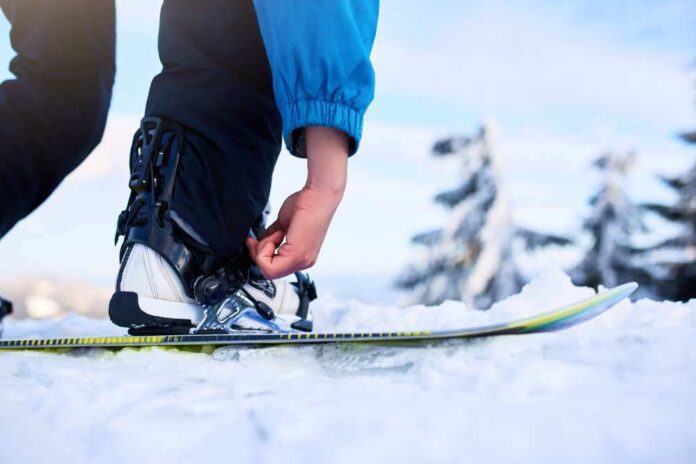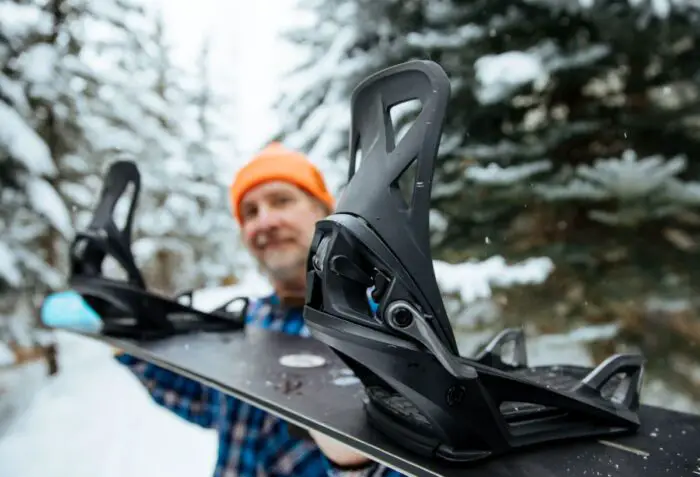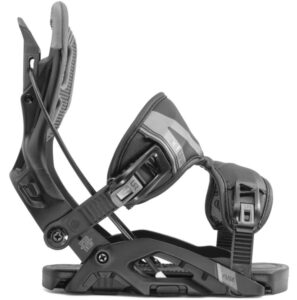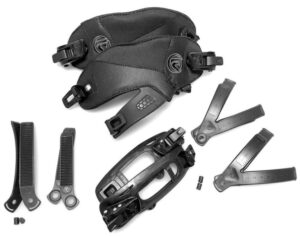
Snowboard bindings are certainly one of the important pieces of equipment for being a snowboarder. Even if you haven’t heard as much about snowboard bindings as you would have about other pieces of equipment like boots for snowboarding or the snowboard itself, finding the right snowboard binding for your physical traits and riding aesthetic is crucial.
You have a lot of alternatives, from flow snowboard bindings to strap snowboard bindings. But what riding style warrants the use of one type of binding than the other? And how do you decide which snowboard bindings are ideal for you?
Here, we’ll go over all you need to remember on both flow and strap bindings, covering their benefits and drawbacks, then you can make a better selection for yourself.
The Snowboard Binding’s Basic Anatomy

Buckles
The buckles ensure that your binding is securely fastened. Buckles on a ladder strap with a ratchet system are extremely convenient and simple to use. In most circumstances, a snug fit on your boots may be achieved with just a few clicks. Buckles are available in a range of materials. Lower-cost bindings are more likely to have lightweight plastic buckles.
Highback
The vertical plate beneath your lower calf is referred to as the highback. It gives you assistance and helps you convey your power to the board throughout turns. There are a number of heights, flexes, and forms available in a range of materials. In general, freestylers and beginners benefit from shorter and softer highbacks. While advanced riders benefit from bigger and stiffer highbacks.
Straps
Two straps are usually found on a snowboard binding. Both the toe and ankle straps are made of leather. The design of ankle straps is rather simple. They loop over your ankle to keep your boot in place while transferring your movement’s energy to the chassis. Padded high-end straps are designed to decrease pressure points and potential foot soreness. Toe straps, however, may vary.
What Exactly Are Flow Bindings?

Back entry bindings, often known as “speed entry bindings,” come in the “flow” kind.
They are still less prevalent than strap bindings, but they are growing more popular as a result of their distinct advantages. The majority of flow bindings just have one strap: a combined ankle-toe strap that wraps around the complete front of the foot.
Because the strap may have two unique parts, one over the ankle and one over the toe, the flow binding may seem to have two straps when it actually just has one. If your toe and ankle require various levels of tightening for security and comfort, you should be capable of adapting these individual pieces independently of one another.
Any changes you make towards the toe strap, on the other hand, will affect the tension of the ankle boot. Similarly, whatever changes you apply to the ankle strap will affect the stretchiness of the toe strap. Although a few flow bindings have totally separate toe as well as heel straps, this is a rare feature.
Your flow bindings’ high-back functions similarly to a draw bridge. The back can indeed be loosened completely, letting it move backward almost fully horizontally. This opens up a huge area where you can simply slip the boots out and into the bindings.
All you have to do to get onto your flow bindings is unhook the high-back and fully open it up so you can slip your boot within the strap. All you have to do now is close the high-back out over the back of your boot and secure it in place.
What Are Strap Bindings?

These strap bindings, also known as “strap-in bindings,” are the most prevalent form of binding you’ll see in stores and on the slopes.
Strap bindings have dual straps: an ankle strap near the top of the foot and a toe strap towards the bottom. The ankle strap crosses your ankle, while the toe strap either lies on top of your boot’s toe or wraps across the front of the boot, as their names suggest.
Strap bindings too have a stable high-back, which means the back stays put, though the inclination of the high-back can be adjusted to lean more forward or stand more upright. This is primarily determined by your comfort level and the slope’s angle.
You must undo both straps in order to really get in or out of the strap restraints. This will make it easier for the boots to enter and exit the bindings. When it comes to strapping bindings, most people will need to kneel down and put these on or pull them off. You can, however, learn to do it from a standing posture with practice, saving time.
Merits of Flow Snowboard Bindings
Flow bindings’ major advantage is how quick and simple it is to strap into them, thanks to its drawbridge-like high-backs that can be totally unlocked.
With practice, you’ll be able to put on your snowboard bindings as soon as you get off a ski lift, allowing you to spend more time on the slopes. You don’t have to sit down in the snow since one can strap in their flow bindings whilst standing up, enabling you to avoid having the seat of your pants wet.
Another advantage of flow bindings would be that the straps only need to be adjusted once, at the beginning of the day. After that, even though you put your boots through and out of bindings numerous times during your trip, you’ll be good for the rest of the day without a need to re-adjust.
Merits of Strap Snowboard Bindings
Your bindings’ two independent straps allow you to alter the tension of each strap individually, which may be important when the ankle needs a particular firmness than your toe.
It’s also easier to utilize strap bindings whilst sitting down, so this option is perfect for steeper slopes where you’ll have to sit down at the start. Since strap bindings seem to be more popular, they are also less expensive, making them more appealing to newcomers to the sport.
Furthermore, while strap bindings require a longer time to put on and take off in normal conditions, they are significantly more trustworthy in the event of a fall or collision. They’re less likely to fly away while sliding down a slope, and if you get caught in a snowbank, they’re a lot easier to get out of pretty quickly.
Demerits of Flow Snowboard Bindings
Flow bindings are designed to be put on more effortlessly while standing. However, this makes it more difficult to put on these snowboard bindings when sitting down, which is occasionally necessary while boarding on a very steep slope.
Furthermore, because the straps on most flow bindings are coupled, you won’t be able to independently change the level of strain on each toe and ankle if you still need to.
When you’re initially learning to snowboard, this could prove more difficult to master about how to arrange flow bindings than that of other types of bindings. Finally, because flow bindings are more pricey than strap bindings, they may not be the best choice for a beginner’s set, especially if you’re just getting started with the sport.
Another disadvantage of flow bindings is that they could make recovery from a collision or fall more difficult. You may not be able to unlock the high-back and then get your boots out of the binding if you ride together into a powdery snowbank with snow jammed up against it.
Also, if you tumble and slide down a slope on your back, you could accidentally activate the flow bindings’ unlocking mechanism, which will send the board flying off your feet! Of course, this is a danger to both you and the board.
Demerits of Strap Snowboard Bindings
Strap bindings’ major disadvantage is that it takes time to put on it and take off. Unlike flow bindings, one must sit down to modify or equip them until they have better technique. In addition, unlike a flow binding, a strap binding’s high-back cannot be opened. Finally, when snow and ice clog the mechanisms, the straps can jam, and you must re-adjust the straps every moment you place on this form of binding.
How to Mount Snowboard Bindings?
Oftentimes, you can get your bindings mounted on your snowboard by a ski store employee or some other specialist on the slopes. Even if that’s your plan, knowing how to mount your own bindings is helpful in case those loosen up over time.
You won’t be capable of turning as quickly or smoothly with loose bindings, which can annoy you or that it might cause accidents.
Actual Way to Mount Flow Bindings
- Check to see if your bindings are compatible with your snowboard. Some bindings and snowboards have different mounting hole patterns, and bindings with a 33 hole will not work on a snowboard with the one that has a 44 design.
- If the hole layouts are incompatible, you might have to utilize a specific angle plate to help you match them up. However, it will be an additional cost.
- Place the snowboard in a firm place when you’re ready to install your flow bindings. If you do need an angle plate, place it at a zero-degree angle in the baseplate of the first foot binding.
- The angle will be indicated by an arrow just on the baseplate. Align the mounting holes upon that snowboard with the holes in the angle plate or the binding itself.
- Make sure the binding, as well as the snowboard, are positioned such that the long line upon that angle plate is perpendicular to the snowboard’s sides.
- Screw four screws into the holes inside this binding or angle plate with an appropriate screwdriver. The screws must be driven all the way through into the angle plate, the binding, as well as into the snowboard.
- Then repeat with the second-footlong binding. If you’re using an angle plate, make sure the base plate of the binding is already at a fifteen-degree angle towards the angle plate this time. Then, just like the previous foot binding, line the holes and screw in the screws.
- All that’s left is to attach the boots to that same base plate, the right boot to the right side, the left boot to the left, and the buckles to the bindings’ straps.
- You’ll be able to ride once you’ve secured the buckles well over boots!
Installing The Strap Bindings
The technique of putting strap bindings on your snowboard is quite similar to putting flow bindings on your snowboard. Check to see if you’ll require an angle plate to match two sets of hole layouts that aren’t the same.
Screw the bindings into place until they are snugly fixed on the board, positioning them at appropriate angles.
The difference with strap bindings is that you must modify the forward lean on the high-back after screwing the bindings to the snowboard. This will depend on your personal choice and your comfort physically, however, for snowboarders, forward leans of ten to fifteen degrees are the most typical.
You want an angle that is comfortable for your knees while still allowing you to bend your legs enough to keep your balance. All you’d have to do is put your snowboarding boots on and go.
Final Words
Snowboard bindings are available in a variety of styles and brands. Considering snowboard bindings really are a crucial aspect of your adventure, you should do your research before deciding on a brand.
The binding you pick must be based on the type of board you’re riding as well as your riding style. Obviously, you need snowboard bindings that are comfortable for your feet. Flow bindings are the appropriate solution for you if you need speed but don’t want to re-adjust the straps of the bindings every single time you put it on or pull it off in a day.
From a standing position, they enable simpler access and quick releases. If you’re new to snowboarding and want to have a pair of bindings that won’t slide off your feet or get stuck in a snowbank, strap bindings are a good option.
Feel free to modify them as required for your comfort in either scenario. Now all you have to do is find the perfect snowboard bindings that fit you and hit the slopes!



















